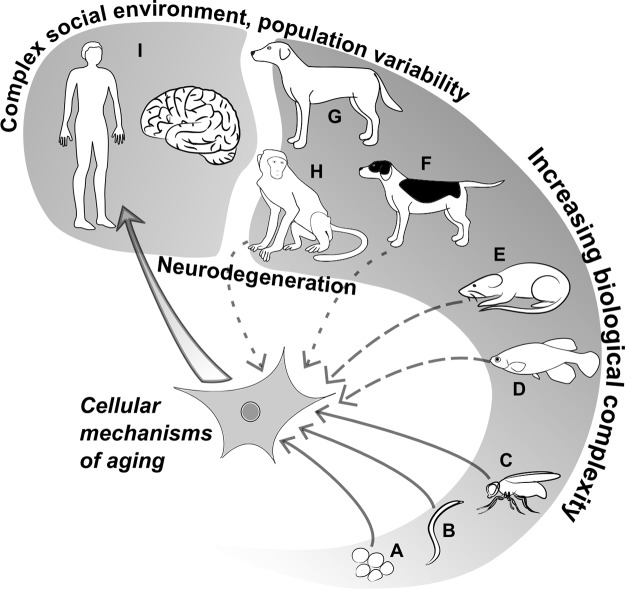Figure 8.
Model organisms of aging. The figure illustrates common aging model organisms, including small animal models and large aninmal models used to study various aspetcs of aging. (A–C) Yeast (Saccharomyces cerevisiae) and the invertebrates Caenorhabditis elegans and Drosophila melanogaster are ideal to experimentally study the basic, conserved mechanisms of cellular – and organismal – aging. On the other hand, they show less biological complexity than vertebrates in many aspects, and they do not naturally develop neurodegeneration. (D–E) Vertebrate small animal models, like the turqoise killifish (Nothobranchius furzeri) and rodents (Mus musculus and Rattus norvegicus) are ideal to study the biological mechanisms that may be absent in invertebrates, and they can still be rather easily used in experimental studies, including genetic manipulations. However, they typically do not develop age-related neurodegeneration, and may lack many aspects of the complex social and environmental influencers of human aging. (F–G) Dogs show similarities to humans in their physiology and they tend to naturally develop age-related cognitive decline. Laboratory dogs (F) are traditional large animal models in pharmacology reserach. However, the same way as other laboratory models, they do not represent the natural genetic and environmental variability typical for human populations. Family dogs, (G) on the other hand, live in the same environment as humans do, and show a special population genetic stratification, with the presence of genetically isolated, diverse populations (breeds). (H) Primates are the closest related to humans, thus they may seem to be the most appropriate animals to study human aging. However, primates are not suited for large-scale sudies for many reasons, including ethical and financial ones. Although they tend to develop human-like age-related neurodegeneration, they still lack the genetic and environmental complexity (both in the laboratory and in their natural habitats), which may influence human aging phenotypes in human populations. (I) Human aging shows many unique attributes, including a high prevalence of neurodegeneration. Age-related neurodegeneration is hard to study in most animals, and translational experiments have had many limitations so far. Brain aging may be fundamentally affected by non-genetic factors, including diet, exercise and social environment, which seem challenging to be modelled under laboratory conditions to reflect the natural circumstances of human populations.

